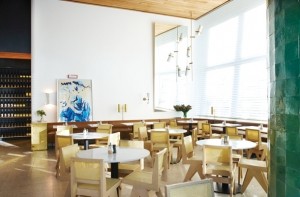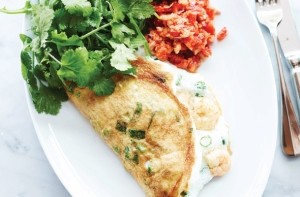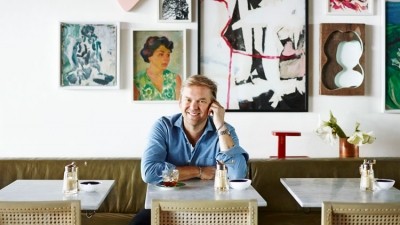Bill Granger on why he wants to be seen as more than just a morning person

Bill Granger’s toothpaste advert worthy pearly whites are threatening to scupper our photo shoot. Usually Restaurant has to cajole its cover stars in to bearing even the faintest of grins but the Australian celebrity cook and restaurateur’s smile is so dazzling there’s a worry it will look like we’ve purchased the pictures from Hello magazine.
We’ve met for breakfast at his west London restaurant to discuss his expansion plans and how his international consumer profile and association with impeccable scrambled eggs and ricotta hotcakes is holding him back from being thought of as a serious restaurateur.
It may come as a surprise to some but the 45-year-old runs a dozen highly successful upmarket-yet-casual restaurants in locations as diverse as Seoul and Honolulu. He has three restaurants in Sydney – Granger opened the first of these in 1996 at just 22 – four in Japan, one in Hawaii and one in South Korea.
He relocated to the UK in 2011 to open Granger & Co on Notting Hill’s Westbourne Grove. As if to prove his Aussie expat credentials he orders Vegemite and toast, which he describes as a taste of home. But he’s clearly happy in this quietly glam location – he lives just down the road with his wife and three daughters – gleefully pointing out Tamara Eccleston’s personalised Range Rover as it passes the restaurant, and beaming at his regulars.
At 11am the restaurant is completely full and a gaggle of hopefuls cluster around the door. Well-heeled locals of all ages – everything from a young mother with her baby through to a couple in their 70s – drink esoteric freshly squeezedjuices and flat whites and order from Granger’s famous breakfast menu. Plates range from the obvious – including an Aussie take on a full English and soft boiled eggs with soldiers – to more adventurous dishes such as courgette fritters with deep-fried egg, halloumi, tahini yoghurt and parsley salad.
A similar scene will be playing out at Granger & Co Clerkenwell which opened in 2013, although the customer base there is markedlydifferent. Both are, he says, pulling in customers by virtue of their own merits rather than an affiliation with a successful food personality.
Removing the media sheen
Since being ‘discovered’ at his first restaurant in Sydney in the early noughties, Granger has penned eight bestselling cookbooks, and starred in several TV series that have been aired all over the world. He is also a regular within the pages of upmarket food magazines, invariably presiding over an idyllic beachside barbecue in a loosely-buttoned linen shirt.
While he’s not losing too much sleep over it, Granger accepts that his celebrity status has damaged his industry rep somewhat and has gradually retreated from the camera’s glare over the past few years. He now picks his projects more carefully.
“It’s hard to be taken seriously as a restaurateur when you’ve got too much presence in the media as a lifestyle chef. What you do loses all mystery and you need a bit of that as a restaurant owner,” says Granger, who runs the business with his wife Natalie Elliott, who also handles his media. “I also don’t have much time, as the focus is on my restaurants at the moment. It takes a big chunk of time to shoot a TV series or write a cookbook.”
Granger also wants to at least partly distance himself from early morning eating, although he’s happy his restaurants are such popular breakfast destinations. “A lot of our bestselling items are breakfast dishes but there’s a lot more going on here. There’s no reason we shouldn’t be as known for the food in the evening.”
At dinner time, the cooking shifts up a few gears, but it’s far from being cheffy. The menu is focused on light, zingy food that’s probably best described as Australian with global influences aplenty. Small plates include whipped avocado with tofu and wasabi as well as shaved cucumber with honeydew melon, feta, pumpkin seeds and coriander, while the mains section lists beef shin cooked in mole with cauliflower rice, avocado, coriander and tomatillo salsa; and a ginger-cured prawn and spring onion egg white omelette with spiced salsa rosso.
It’s an adventurous offer, yet Granger dismisses his own skills in the kitchen with a wave of a manicured hand. “I don’t see myself as a chef. I didn’t go to trade school and I’m almost entirely self-taught. I’m a well-meaning amateur,” he says, not entirely convincingly.
Later this month Granger will open a third Granger & Co in King’s Cross below Google’s offices on the ground floor of the Stanley building on St Pancras Square. “We love the location. The development of King’s Cross has created a new focal point for London and the people behind it have been really clever about the mix. There’s Google but we also have Central Saint Martins and Cancer Research. It doesn’t feel like a soulless office area and the quality of the restaurants already there is fantastic.”
When the new site opens, its owner will most likely be found interacting with customers on the restaurant floor or polishing the cutlery near the pass. In the early stages of his career he cooked at his Sydney restaurant but he now says he leaves it to the professionals. “It sounds odd but polishing the cutlery is a great job for a restaurateur to do. I can see the dining room and keep an eye on the kitchen too. I don’t cook or run the pass but I do taste. They’re my recipes and I know whether it’s right or wrong.”
Breakfast and beyond
Born in Melbourne, Granger briefly studied architecture before moving to Sydney in the late ’80s to study fine art and took a job waiting in a restaurant. He’d been interested in cooking from an early age, poring over his mother’s copies of Australian Women’s Weekly before moving on to more heavyweight food texts by the likes of Elizabeth David, Jane Grigson and Ada Boni.
When he invited his boss Christine Juillet round for a meal, she was so impressed she suggested Granger come and work with her in the kitchen. After a few months, he started running what might now be termed pop-ups in the evenings when the restaurant was closed. A little after that he started applying for leases after persuading his grandfather to lend him a small amount of start-up cash.
“Nobody would give me a lease, but if I was a landlord I wouldn’t have given me a lease,” he says. “I was young and inexperienced. The good thing about being young is you don’t need much money to live on and there’s less to lose – you don’t have a wife and kids to think about. I get a lot more stressed opening restaurants now than I did back then.”
Eventually a landlord took a punt and Granger opened his first Bills restaurant in the colourful Sydney suburb of Darlinghurst. The focus on breakfast and communal eating came about because he wasn’t allowed to trade in the evening and the space was so tiny a single 34-seater table was the most efficient way to seat his customers.
Bills was a well-known and influential restaurant from day one, but Granger’s consumer profile only started to develop around the year 2000. It was the height of the boom in lifestyle food TV and producers were looking for an Aussie answer to Jamie Oliver. The restaurant’s reputation for great breakfast food and coffee in a city not short of morning eating options got their attention and Granger’s screen-friendly persona sealed the deal.
“It wasn’t something I sought out. I don’t think that’s really possible. When a chef gets an agent and tries to be the next big thing it rarely works out. You need to wait for people to approach you and for that you need to be great at what you do,” he says.
Will the real Bills stand up
All of Granger’s restaurants outside the UK are called Bills but the presence of casual dining chain Bill’s ruled out that name on these shores.
Granger says he’s not sure if he would have used his first name here but it seems likely that would have been the preferred option, particularly as he now regularly has to politely distance himself from the much larger Richard Caring-owned group. It’s easy to see where the confusion has arisen as the proposition of Bill’s and Granger & Co is nearly identical, not least their eclectic menus and a fanatical focus on all-day dining.
“People think Bill’s is me all the time. But I don’t believe it has affected our success. We’re not trying to create some massive global chain so it’s not a huge issue for us. We have a different identity. Bill’s is more casual and I think Granger & Co and Bills are a little more sophisticated.”
The first Bills was soon followed by locations in other Sydney suburbs, including Surrey Hills and Woollahra. “Our expansion has not been particularly strategic,” Granger admits. “I open restaurants in places that I like and want to go to on a regular basis. We run a restaurant in Honolulu because I wanted an excuse to be there. From a UK perspective operating restaurants in Japan and Korea may sound strange but it feels more natural to me as an Australian. Our food is zingy and light and global so it’s perhaps more suited to the Asian palate than, for example, traditional British food.”
The group’s first restaurant outside Oz launched in 2008 in Shichirigahama, Japan, a trendy city packed with creative types an hour and a half from Tokyo. The restaurant opened before Granger had much profile in the country.
“We built it up slowly. I tested the market with an extended pop-up, which was well-received, and I did an hour-long special on [TV channel] NHK, but that was about it. I was very far from being a household name. In fact, the majority of people didn’t have a clue who I was.”
A lot more people do now, however. Despite this relatively low-key approach the restaurant has proved a sensation with people happy to wait the best part of a day for a table. “In Japan the idea of a restaurant or chef communicating lifestyle is a new thing. In my view Japanese cuisine is the best in the entire world, but restaurants are often just about the food. People really warmed to the idea that a restaurant could be somewhere to hang out,” he says.
Granger followed the advice of his Japanese restaurateur business partner for his restaurants there and adjusted the menu, removing a number of items that were deemed too foreign.
“The Japanese are obsessed with Italian and French food but we thought there would be a few things they’d struggle with, including porridge,” Granger recalls. “But over time most of the things we’ve taken off have gone back on.”
Three more restaurants followed and another Bills will open in Japan this September, taking the group up to five locations in the country.
The restaurant in Seoul, South Korea – again co-owned with a local business partner – came about because the Bills restaurants in Tokyo serve a lot of Koreans away for work and play. It’s been so successful another is in the works.
Keeping it local
The group’s management team is small, with most of the operational decisions devolved down to the individual restaurants. “That’s the only way it would work because the restaurants are in very different locations. Running a restaurant in Seoul is obviously very different to running one in London. But I also think it’s crucial that the people who run the business are the same people who are in the restaurants each and every day,” says Granger, who works with a “small and agile” creative team to design the restaurants and put together the menus.
Granger says the majority of his restaurants’ key dishes have been on the menu for many years, but with a long-standing barbecue section and flashes of Korean and Japanese cooking, his menus are ahead of the game in trend terms.
“I never try to second-guess the market. I trust my own judgement and I’d encourage any other restaurateur to do the same,” he says. “If it’s not the sort of food I’d want to eat it doesn’t go on to the menu. Korean food is big in the US at the moment and has been a mainstay in Australia for decades, so it’s not surprising that it’s now gaining momentum in London.”
As an experienced food writer, Granger perhaps has a better grasp of food fashion than most restaurateurs. He compares the cyclical nature of food trends to haute couture: some things never change while others are in a constant state of flux.
“Many of our biggest sellers have been on the menu for 20 years but when you’ve been in the business for a while you start to see things coming round again,” he says. “A few years ago there was a big emphasis on authenticity and being very specific about where things come from, but now it feels like fusion is coming round again, although you’d never dare call it that. In a few years’ time we’ll probably switch
back to something a bit more specific. But for the moment I’m enjoying the freedom to put a few drops of tamari into my Italian dressings.”
He’s responsible for a fair few trends himself. Back in Oz he is widely credited with the creation of the communal dining scene and his obsession for eggs and cooking them properly has caused a resurgence of eggs in foodie circles in countries including the US and over here.
For a well-meaning amateur Granger is a tastemaker in food media and now with restaurants spread across four continents, he can be considered an influential restaurateur too. Much like Jamie Oliver, Granger’s key appeal is his affability and the approachability of his recipes whether they’re in a book or on the plate.
“I’ve always cooked happy days food. Everything is domestic and approachable,” he says with a final flash of brilliant white teeth.
“I’m sure a lot of proper chefs look at what I do and wonder why on earth I’ve been so successful. Sure, it’s nothing complicated, but it’s what a lot of people want to eat.”
All day, all night
Granger & Co and Bills three finely-tuned menus ensure a steady stream of trade throughout all day parts.
What’s served across the international group varies slightly from location to location but the content and structure of the menus is very similar, with all dishes selected from a pool of recipes conceived by Granger and his creative team. Granger & Co and Bills are the masters of all-day dining and their menus should be considered essential reading for any restaurant struggling to pull in customers in the morning and mid to late afternoon.
All the restaurants offer three different menus over the course of the day: a breakfast menu (opening to midday), a lunch menu that includes a range of all-day dining-friendly dishes (midday to 5pm) and an evening menu (5pm until close).
The breakfast menu is creative and packed full of flavours not usually associated with early mornings (in this country, at least).
Options range from healthy – fruit with yoghurt and bee pollen; egg white omelettes – to more sustaining plates including chicken fat-fried rice with raw vegetables, brown rice, arame, pickles, chilli-fried egg and sprouting seeds; and ricotta hotcakes with banana and honeycomb butter. A small list of interesting sides can be added to all breakfast dishes, including miso mushrooms and cumin roast tomatoes.
At lunchtime the menu lists fresh juices, a selection of premium sandwiches, salads, pasta dishes and a big plates section including a yellow fish curry served with spiced butternut squash, roast peanuts, jasmine rice and cucumber relish. A Bill’s classics section also lists a number of the most popular dishes on the breakfast menu, including Granger’s famous scrambled eggs. The evening menu majors on small plates, big plates and barbecue dishes. Small options include miso aubergine with fried tofu and shiso as well as Korean fried chicken, iceberg lettuce, spring onion and chilli sesame, while large options and BBQ’d options include salmon salad with a coconut caramel dressing and turmeric spicedchicken with slaw, peanuts and lime and coconut dressing.
Prices in the UK are mid market, with main course plates around the £15 mark and small plates priced between £4 and £12. Interestingly, the top 10 bestseller list for each restaurant is exactly the same around the world and is dominated by breakfast and all-day-dishes including sweetcorn fritters with roast tomato, spinach and bacon and Parmesan-crumbed chicken schnitzel and fennel slaw.



































